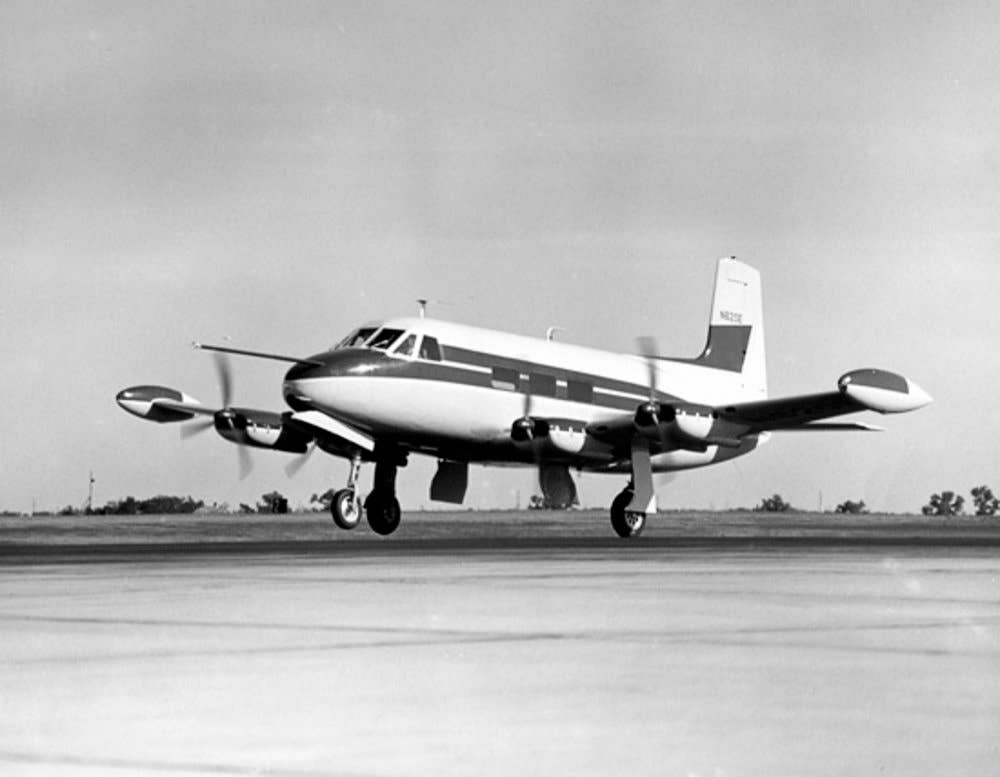The Four-Engined Cessna and Its Corporate Mission
Cessna’s predecessor to the Fanjet 500, the Cessna 620, never made it to market, but it proved a point.

At 15,000 pounds with a wingspan of 55 feet, the 620 dwarfed the company’s existing offerings. [Credit: Textron Aviation, Inc, all rights reserved]
The late 1950s were an exciting time for Cessna. Demand for general aviation aircraft was robust, and thus, the company invested significant resources into identifying and pursuing emerging markets. One such market during that time was corporate travel.
Corporate aviation had existed for decades, but the post-war environment rekindled the segment. A handful of companies converted larger, former military types into executive aircraft, but most new models under development—such as the Aero Commander 500 series and Beechcraft Queen Air—had relatively small cabins. Others, like the Twin Beech, were relatively slow and lacked pressurization. Cessna saw an opportunity.
Launching a massive market research project, Cessna interviewed several hundred executives and corporate pilots who either operated or were interested in purchasing a new corporate aircraft. As Cessna’s marketing team categorized and studied the responses, they identified six very consistent concerns: safety, all-weather capability, comfort, speed, economy, and general utility. Using these themes as guidance, the engineers got to work.
In 1956, the Cessna 620 emerged. Its name derived from having twice as many engines as the 310, the four-engine pressurized corporate aircraft was something altogether different for Cessna as well as for the market as a whole. With a wingspan of 55 feet, a fuel capacity of 535 gallons, and a maximum takeoff weight of 15,000 pounds, it was by far the largest civilian Cessna model to date.
The 620s design and performance reflected the marketing study perfectly. The four-engine configuration was regarded as a significant safety feature compared to existing twins. It was equipped with a Garret turbine auxiliary power unit (APU) that pressurized the cabin, and supercharged, 350 horsepower Continental GSO-526 engines that enabled a service ceiling of 25,000 feet and provided a means of flying above inclement weather.
The 620’s tall cabin enabled comfortable movement within. [Credit: Textron Aviation, Inc, all rights reserved]
Compared to existing 6- to 8-place cabins, the 620’s cabin was massive. The oval cross section provided six feet of height, various seating configurations could be utilized, and niceties such as a lavatory and baggage area were installed for long-distance comfort. Comfort was important, as achieving the maximum 1,700 miles of range at a cruising speed of 260 mph would mean long stints aloft.
The cruise speed was reportedly considered acceptable by the focus group, however. This was fortunate, as it enabled the use of smaller piston engines as opposed to turboprops, which Cessna reasoned would have resulted in an unacceptably high purchase price. Cessna also touted the piston engines as more easily serviceable at out-of-the-way locations than turbines.
Convinced the 620 had a bright future, Cessna constructed a full-size cabin mockup and sent it to trade shows, where it was showcased alongside existing aircraft. Smaller mockups and technical displays accompanied the cabin mockup, touting the 620’s ability to utilize its APU where ground power wasn’t available. The marketing team also displayed individual technical components of the aircraft such as an engine and a propeller.
Cessna’s marketing effort for the 620 was strong, utilizing both miniature and full-sized cabin mockups. [Credit: Textron Aviation, Inc, all rights reserved]
In August 1956, the 620 made its maiden flight. Test pilots reported great handling characteristics, and Cessna began collecting refundable deposits. The price of the 620 had increased substantially above the original target price, however, and had reached $375,000—the equivalent of $3.9 million today.
For perspective, the Learjet 23, which was only about five years away, would initially sell for $489,000. While still a significant premium above the 620, it would be a sign that smaller corporate jets were poised to take over. Additionally, sales numbers of corporate piston aircraft such as the Howard 250 were relatively small, further suggesting the segment’s future would burn jet fuel.
Cessna President Dwane L. Wallace (left) poses with the 620. [Credit: Textron Aviation, Inc, all rights reserved]
Just over a year later, Cessna made the decision to cancel the 620 program entirely. The single prototype was scrapped, and the company’s largest corporate aviation offerings would be limited to the 400-series twins until 1968, when the Fanjet 500 would make its debut. This, of course, would evolve into the wildly successful Citation series of business jets.
Whether the 620 would have captured a significant share of the market during that ten-year gap is arguable. It’s possible Cessna could have sold enough of them to create a notable chapter in corporate aviation history. But it’s also possible the development, launch, and manufacture of the unusual four-engine airplane might have robbed critical resources from the development of what would become the Citation, thus hobbling the company for decades to come.
The 620, therefore, is relegated to a curious and unique footnote in the history of corporate aviation, demonstrating what can be accomplished with outside-the-box thinking…and also what can be accomplished by instead opting to pursue more viable alternatives.

Sign-up for newsletters & special offers!
Get the latest FLYING stories & special offers delivered directly to your inbox






